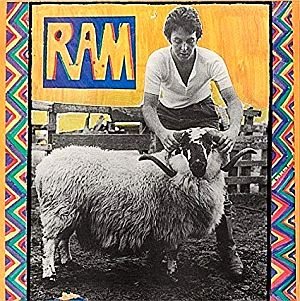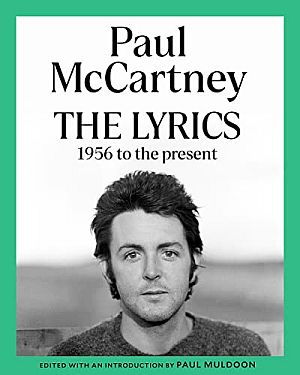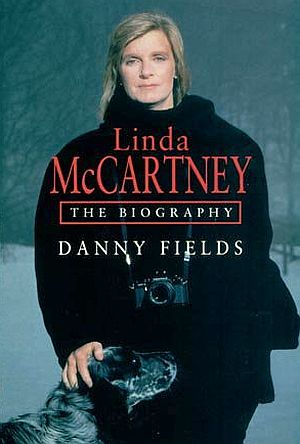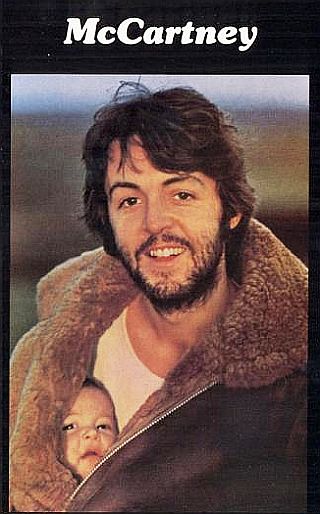
Photo from back cover of “McCartney” album, April 1970, his first solo album. Photo of he and daughter Mary, tucked inside his coat, by Linda McCartney, shot in Scotland. Click for album.
Paul McCartney, John Lennon, George Harrison, and Ringo Starr were having both creative differences over musical direction and business disagreements. In August 1967, they had lost their friend and business manager, Brian Epstein, then 32, to a drug overdose and were now navigating the business world on their own. Apple Records, their new label, was created in 1968, but a rift ensued when Allen Klein came in as manager with the support of Lennon, Harrison and Starr, while McCartney wanted his wife’s father, entertainment lawyer Lee Eastman, to be manager.
On the musical front, too, there were serious fissures in the group, some dating to early 1968 and a couple of walk outs. But as they worked on the final sessions for what would be their last album together, Let it Be, the rifts were widening and near rupture.
By then, each of the Beatles had been thinking about, or had launched, solo projects. John and Yoko Ono had already recorded. George Harrison, frustrated with Lennon-McCartney domination, had put out a solo album in January 1968. Ringo was pursuing some film interests and also had a solo album in the works. And Paul McCartney, too, had begun working on songs for a possible solo album.
But for McCartney, the period leading up to his work on that solo album had become a rough, uncertain time, borne by the prospect of the Beatles breaking up, which had set him adrift. In September 1969, John Lennon had privately announced to the group (and not the public) that he wanted to quit the Beatles, though at the time it was unclear whether he meant permanently. Still, Paul had taken John’s announcement to heart, and it left him bereft. The Beatles were practically everything Paul had ever done. So what now?
McCartney then retreated with his wife and young family to his farm in Scotland, a remote place on the Kintyre peninsula they also called the High Park farm. At the farm, however, McCartney went through a very down period of brooding, drinking, and depression over the likely demise of the Beatles and his uncertain musical future. He and his first wife, Linda – Linda Eastman, an American photographer – were married for less than a year at that point, having wed in March 1969.
|
“Maybe I’m Amazed” Maybe I’m amazed at the way Maybe I’m a man and maybe Maybe I’m a man and maybe Maybe I’m a man and maybe Maybe I’m a man and maybe Maybe I’m amazed at the way |
Linda then had her hands full with her 7 year-old daughter Heather from an earlier marriage, plus their newborn baby, Mary. Still, Linda became the rock in helping Paul weather the Beatles’ turmoil and getting him back on track. She encouraged him musically, boosting his confidence, helping him to finish his solo album, which he had already started. Then, from late December 1969 through late March 1970 – working mostly at the McCartney London home, he set about working on that solo album, which would be titled, McCartney and would include an assortment of 13 songs, some of which had begun as earlier-composed fragments. One of the songs — “Maybe I’m Amazed,” dedicated to Linda — would become a top hit in the U.K. and America, and one of Paul’s most famous songs.
Music Player
“Maybe I’m Amazed”
Paul McCartney – 1970
McCartney recorded the album in secrecy, mostly using basic home-recording equipment – a Studer four-track tape recorder – at his house in St John’s Wood. Some of the material dated to ideas he had years earlier. One of the songs, “The Lovely Linda,” was written at the farm in Scotland. McCartney played all the musical instruments for the songs – acoustic and electric guitars, bass, keyboards, drums and various percussion instruments. Linda supplied backing vocals on some of the songs. There was also some mixing and later recording for some of the songs at two studios in London – the Abbey Road studios and the Morgan Studios, the latter to copy the four-track recordings onto eight-track tape for overdubbing (more on the album later).
But it was “Maybe I’m Amazed” that stood out on the album — an ode and love song to Linda, as the lyrics make plain. It was Paul’s tribute to his wife for bringing him out of his funk and restoring his confidence. She was his muse and inspiration; the one who steadied him through a difficult time.
The McCartney album is also noted for its photo art by Linda, one sample of which is shown at the top of this story from the album’s back cover — a photo of Paul taken at their farm in Scotland. Paul is shown in a fur-lined winter coat with baby Mary peering out from her snug position, tucked inside Paul’s coat. Additional photos by Linda used in that album included a collage of 21 family snapshots in the inner gate-fold spread – images of Paul, Linda, Heather, newborn Mary, and the family sheepdog.
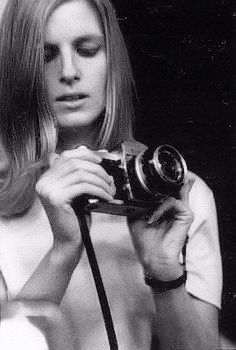
1960s: Photographer, Linda Eastman.
Linda Louise Eastman was born in Scarsdale, an affluent community in Westchester County, New York. Her father, Lee Eastman, practiced entertainment law in New York and had well known clients such as Tommy Dorsey, songwriters Harold Arlen and Jack Lawrence, and artists Willem de Kooning and Mark Rothko. Her mother, Louise Sara (Lindner) Eastman, was the daughter of Max J. Lindner, founder of the Lindner Company clothing store of Cleveland, Ohio.
Linda graduated from Scarsdale High School in 1959, attended Vermont College for an associate degree in 1961, and then to the University of Arizona to study Fine Arts, also taking up nature photography there as a hobby.
Linda’s mother had died in a plane crash in March 1962. Linda married Melville See Jr., in June 1962, whom she had met in college. Their daughter, Heather, was born that December. Linda’s mother had left Linda an inheritance to live on plus some paintings.
In June 1965, Linda and Melville divorced, and thereafter Linda took a job as a receptionist and editorial assistant for Town & Country magazine.
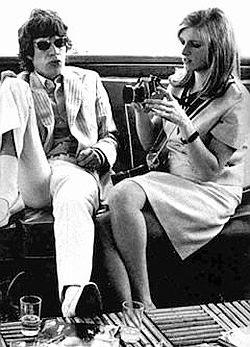
Linda Eastman at a 1960s photo shoot with Mick Jagger of the Rolling Stones.
A big break for her came with a Rolling Stones shoot on a yacht where she was the only photographer. Linda’s father, however, was not impressed with her becoming a photographer, as her siblings had gone on for further education.
Nevertheless, during the 1960s, Linda Eastman became an unofficial house photographer at Bill Graham’s Fillmore East concert hall in New York, photographing a range of rock acts.
Among the artists and groups she photographed at the Fillmore and elsewhere were: Aretha Franklin, Grace Slick, Jimi Hendrix, Bob Dylan, Janis Joplin, Eric Clapton, Simon & Garfunkel, the Who, Jim Morrison and the Doors, the Animals, John Lennon, and Neil Young. In May 1968 she photographed Eric Clapton for Rolling Stone magazine and became the first woman to have a photograph featured on Rolling Stone‘s front cover.
Meeting Paul
In May 1967, while on a photo assignment in London, Linda met Paul McCartney. She was then doing a photo shoot of blues and jazz performer Georgie Fame performing at the Bag O’Nails club. Paul and Linda met again four days later at the party for the launch of the Beatles’ Sgt. Pepper’s album at Brian Epstein’s house. In May 1968, they met again, this time in New York, while Paul and John Lennon were there to inaugurate Apple Records.
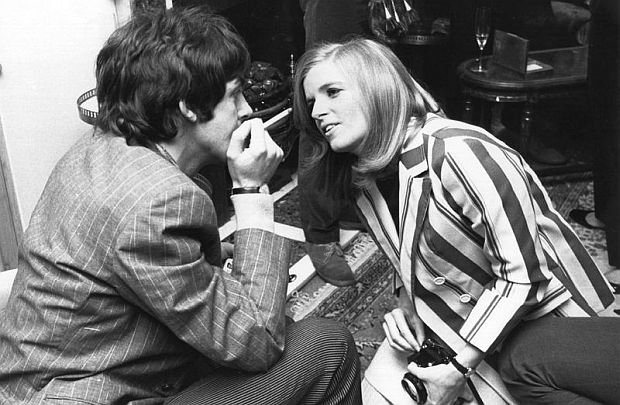
May 1967. Early dating. Linda Eastman talks to Paul McCartney at launch party for Beatles album “Sgt Pepper’s Lonely Hearts Club Band.” The couple would marry two years later, in March 1969. Photo: John Pratt
A few months after their May 1968 meeting in New York, and after McCartney returned to London, he invited Linda to spend some time with him there. When she arrived, they went to his home, where they spent the evening together.
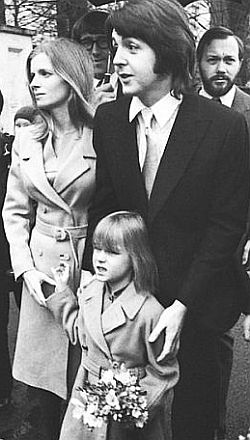
March 1969. Linda & Paul McCartney at their wedding, with daughter/flower girl Heather.
McCartney would note that Linda had a rebellious streak growing up, was a “very free spirit,” considered something of a black sheep by her family, not choosing to excel in education like her father and brother. “She was an artist,” McCartney would say of her, “and was not cut out to be an academic.” They both shared a love of nature, which became one of their most important emotional links.
When Paul and Linda first began seeing one another, Paul also took readily to Linda’s daughter from her first marriage, Heather, then six years old. He insisted that Linda and Heather move to London to live with him. After they did, Paul took time with Heather, reading her stories, drawing with her, and sometimes, singing her bedtime tunes.
On March 12, 1969, Linda and Paul were married in a small civil ceremony in the Marylebone area of London. Young ladies around the globe were broken-hearted, as Paul was now a married man.
John Lennon married Yoko Ono a week later, and both women were sometimes wrongly cast by fans as the reasons why the Beatles broke up. Lennon at one point publicly criticized the press for its treatment of Linda: “She got the same kind of insults, hatred, absolute garbage thrown at her for no reason whatsoever other than she fell in love with Paul McCartney.”

November 1969. Among the photos taken by Life magazine of Paul, Linda and family in Scotland. Click for magazine copy.
“Scotland was like nothing I’d ever lived in. It was the most beautiful land you have ever seen, way at the end of nowhere. To me it was the first feeling I’d ever had of civilization dropped away … so different from all the hotels and limousines and the music business, so it was quite a relief.”
But it was also around this time – from about September through December 1969 – when the “Paul-is-dead” hoax story was in its most heated form (see separate story here), with supposed Beatles song and album image “clues” all feeding into a mini-media frenzy.
Perpetrated mainly by college students and some disc jockeys, the story had it that McCartney was supposedly killed in a 1966 car crash and had been quietly replaced by a look-alike to spare Beatles’ fans and keep the group on track. None of it was true, of course – a big false story – which a Life magazine cover story of November 7, 1969 dispelled quite directly, finding Paul, with family, very much alive and well in Scotland.
The Solo Album
The production of the McCartney album, meanwhile, was taking form. A purposely low-tech affair, the songs on the album were mostly absent the Abbey Road studio treatment and wizardry of Beatles’s productions, since it was McCartney’s goal to produce a “getting-back-to-basics” selection of tunes.
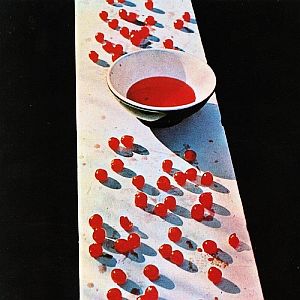
April 1970. Front cover, “McCartney” album. Bowl with cherries photographed by Linda. Click for CD or digital.
Side one
“The Lovely Linda” – 0:43
“That Would Be Something” – 2:38
“Valentine Day” – 1:39
“Every Night” – 2:31
“Hot as Sun/Glasses” – 2:05
“Junk” – 1:54
“Man We Was Lonely” – 2:56
Side two
“Oo You” – 2:48
“Momma Miss America” – 4:04
“Teddy Boy” – 2:22
“Singalong Junk” – 2:34
“Maybe I’m Amazed” – 3:53
“Kreen-Akrore” – 4:15
The album cover, a photo of an emptied bowl with cherries strewn across a white strip, was taken by Linda when on vacation in Antigua.
During the release of the McCartney album, meanwhile, there had been something of an ongoing battle behind the scenes between Paul and the other Beatles, and their record label, Apple, over the timing of releasing Paul’s album (also from Apple), versus the Beatles’ Let it Be album, plus a scheduled album from Ringo. Eventually – after some unpleasantness between Paul and others – Paul’s album was set for April 17, 1970, to precede the Let it Be album, which would come out later, on May 8, 1970.
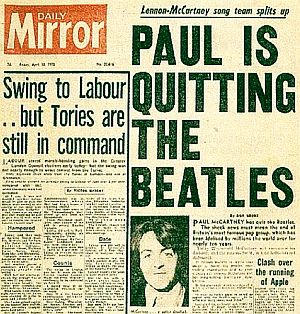
April 1970. UK news story on Paul quitting the Beatles. Lower headline also notes, "Clash Over The Running of Apple".
McCartney was released in Britain on April 17, 1970, and three days later in the U.S. In the UK, the album debuted at No. 2, where it remained for three weeks behind the best-selling album of 1970, Simon and Garfunkel’s Bridge Over Troubled Water.
Although McCartney’s standing among Beatles fans had plummeted as a result of his announcement that he was leaving the Beatles, news of the band’s break-up ensured that the album was highly publicized and helped it gain notice.
By May 15th, 1970, McCartney had sold over 1 million copies in the U.S., and from May 23, 1970, McCartney began a three-week stay at No. 1 on the Billboard album chart, eventually going double platinum.
Despite the album’s good sales performance, a number of music critics dismissed the work as mediocre – with the exception of “Maybe I’m Amazed.” A few praised Paul’s skills with melody on some of the tracks, or noted it’s home-made quality. Rolling Stone reviewer, Langdon Winner, found most of the songs “distinctly second rate” relative to McCartney’s best work as a Beatle.
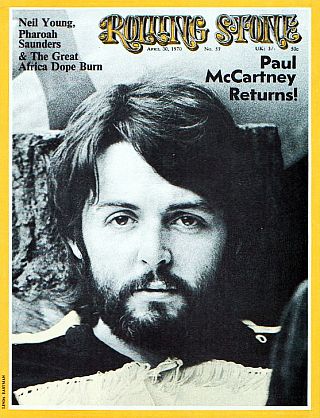
April 30, 1970. Paul McCartney interviewed for “Rolling Stone,” in which, among other things, he spoke about his solo album and the Beatles. Click for magazine or Kindle subscription.
Yet Paul had set out to make a minimalist, no-frills-just-the-basics collection of songs, and admitted to some experimentation, and that it was not on a par with the studio-engineered, George Martin-helmed Beatles albums.
Paul McCartney was interviewed for the April 30, 1970 edition of Rolling Stone, in which, among other things, he spoke about his solo album and his desire to become a broader musician.
“From very early on, when our bass player [Stuart Sutcliffe] died, I have been lumbered with the bass,” he said. “All the time, however, what I really wanted to do was play guitar and play lead, so that’s what I’ve done on this LP [i.e., McCartney].”
Paul, at the time, was also personally unwinding, taking a respite from the fast-paced music world. He was also enjoying the contentment of family life, his marriage, and being a new father.
In his Q&A released on April 10, 1970, Paul described the theme and feel of the McCartney album as, “home, family, love.” The music on McCartney, his website would offer some years later, “represented a creative rebirth, bursting with new ideas, experiments, playfulness and freedom.”
In any case, the album was no doubt buoyed by the popularity of “Maybe I’m Amazed,” as Paul did not release that song as a single. However, the song did receive a great deal of radio airplay worldwide, helping boost McCartney album sales, and making the song one of Paul’s most recognizable solo successes.
Ram & Wings
In 1970, Paul taught Linda to play keyboards and the couple began working on an album together that would be titled Ram, with a Linda McCartney photo of Paul and a ram from Scotland on its cover. This album was produced with the help of a few other musicians, but was mostly a Paul and Linda project, recorded in New York city between October 1970 and Mach 1971.Ram was released in May 1971. One of its songs, “Uncle Albert” became a hit, while others on the album stirred some Beatles controversy, construed to be musical digs aimed variously at John and Yoko (“Too Many People”) and George, John and Ringo.(“3 Legs”).
“Another Day,” a song recorded by Paul and Linda McCartney during the Ram sessions in New York, was also a Top Ten single in the U.S., UK, and elsewhere. It was later included on subsequent editions of the Ram album in 1993 and 2012.
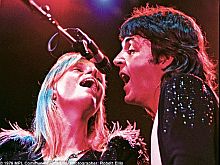
May 1976. Linda & Paul performing at Wings concert, Madison Square Garden, New York.
Although Wings had periods of changing personnel, it was anchored by its core trio of Paul, Linda, and former Moody Blues singer, songwriter, and guitarist, Denny Laine. Of the nine albums released by Wings in the 1970s, all went into the Top Ten in either the UK or the U.S., with five consecutive albums topping the U.S. charts. Wings also had 12 Top Ten singles in the UK and 14 Top Ten singles in the U.S., including six at No 1. All 23 singles released by Wings in the 1970s reached the U.S. Top 40.
Wings also produced the notable James Bond theme song and 1973 hit, “Live and Let Die.” And seven years after McCartney debuted “Maybe I’m Amazed” on his solo album, Wings released a live version of the song as a single from their Wings Over America album. In early February 1977, that single rose to No. 10 on the U.S. Billboard chart and No. 28 in the UK.Another Wings single in 1977, “Mull of Kintyre,” a tribute to the Kintyre peninsula in Scotland where the McCartney farm is located, became one of the best-selling singles in UK history.
In some ways, Wings, especially through the 1970s, was Paul still getting over and proving himself after his separation from the Beatles, and doing so, again with Linda’s help and presence throughout. The two were practically inseparable.
During the 1970s, in fact, the whole McCartney family was involved with Wings on the road, as Paul and Linda had their children in tow as well, which was surely a challenge at times, but which Paul has reflected was an important and memorable time. Professionally, Paul has also reflected, that the Wings Over America tour of 1976 was particularly gratifying, as it had turned out Beatle-equivalent crowds and recognition at tour stops, which was especially satisfying to Paul.
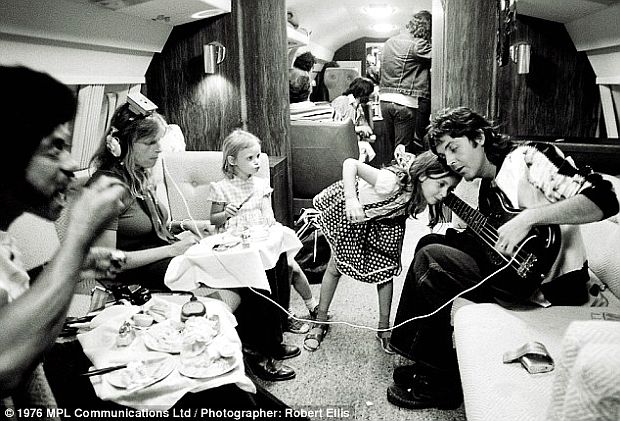
June 1976. The McCartneys & crew during dinner aboard their private jet over America during Wings tour. Mary is trying to hear Paul's guitar while Linda listens on headphones across the aisle, and Stella, to Linda’s left, looks on.
Linda & Legacy
Linda, meanwhile, also became an animal rights activist and wrote and published several vegetarian cookbooks. She and Paul founded the Linda McCartney Foods company, a successful vegetarian business marketing a range of food products in the 1990s, making her a millionaire in her own right. A book of her photographs was also published in 1992: Linda McCartney’s Sixties: Portrait of an Era.
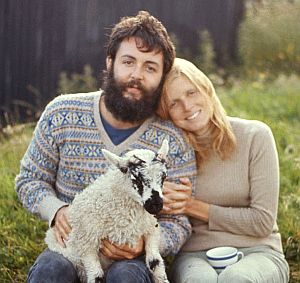
Paul, Linda & friend, possibly at farm in Scotland, early 1970s.
In January 2000, Paul announced donations in excess of $2,000,000 for cancer research at the Memorial Sloan-Kettering Cancer Center in New York and the Arizona Cancer Center in Tucson, where Linda received treatment. Also that year, The Linda McCartney Centre, a cancer clinic, opened at The Royal Liverpool University Hospital.
Linda and Paul McCartney were married for 29 years, raised four children together. In addition to Heather, from Linda’s first marriage whom Paul adopted, the couple had three children, Mary, Stella, and James. And except for ten days Paul spent in jail in Japan on marijuana charges, the couple had never been apart. In April 1999, Paul McCartney, and others, performed at the “Concert for Linda” tribute at the Royal Albert Hall, which had been organized by two of their friends, Chrissie Hynde and Carla Lane.
Linda’s photographic work, meanwhile, has been reprinted in several books and exhibited at more than fifty galleries around the world, including the Victoria and Albert Museum in London. Paul McCartney retains Linda’s photographic legacy, and in recent years has made selections of her photos available for public exhibits, donating some of her work to British museums. Regarding Linda’s talent as a photographer, Paul would note, “she always put people at ease, no matter who she was taking a photograph of…She just had a way of disarming you.”
|
A Memorable Photo Linda Eastman McCartney took hundreds of photos, both during her early career as an entertainment photographer and after she was married to Paul McCartney. Some of her photos captured the Beatles at work. And one of those photos – the one shown below – is of John Lennon and Paul McCartney at work in 1968 during their Beatles career. To the right of the photo, Paul explains the context and his feeling about this photo and its importance to him, as he described the photo and context in a June 2019 interview with the London newspaper, The Guardian, discussing several of Linda’s photos for that story. Here’s Paul:  1968. Linda McCartney photo of John Lennon and Paul McCartney at work at Abbey Road studios, possibly composing a song together. “So this picture is a blessing for me. It’s like, this is how we were: this is why we related, or else we couldn’t have collaborated for all that time. It sums up what our relationship was like the minute we were actually working on a song, and most of the time we were together, really. I’m just writing something out – possibly it’s a medley or something; it might be for Abbey Road – and it’s lovely, because John is very happily in on the process, and agreeing with me, and we’re laughing about something. Just seeing the joy between us here really helped me, because it reminds me that the idea we weren’t friends is rubbish. We were lifelong friends, our relationship was super-special. “That applied to all the Beatles, even when we were pissed off with each other from time to time. People used to remind me: that’s families, that happens. Mates disagree. As soon as we started working on music, we gelled, we just enjoyed the noise we made together, we enjoyed playing with each other. We’d worked together for over 10,000 hours over the years, and that old spirit automatically kicked in. Any disputes were got over very quickly.” |
Paul McCartney, meanwhile, remains part of two giant musical legacies – The Beatles, and since the Beatles with Wings and numerous other projects – as he continues to this day with his solo work, various collaborations, forays into classical music, stage and video productions, and more.
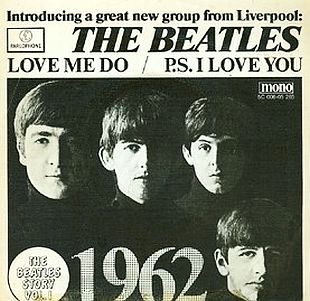
Vintage 1962 record sleeve for first Beatles hit. Click for collector’s box set of 14 Beatles albums in vinyl or CD editions.
The Beatles were inducted into the Rock and Roll Hall of Fame as a group in 1988, and all four were also inducted individually between 1994 and 2015.
As noted earlier, the Wings and Paul McCartney output during the 1970s was quite successful, with multiple platinum-selling No. 1 albums and more than 20 Top 40 hits.
Following the Wings era, McCartney continued writing, composing and touring. Since 1989, for example, and continuing through 2018, Paul McCartney has completed more than 15 concert tours, encompassing hundreds of shows, including 50 most recently during his Freshen Up Tour of the 2018-2020 period.
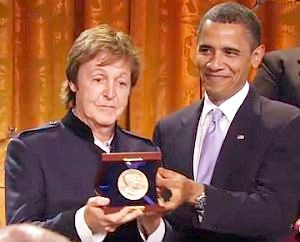
2010. Paul McCartney collecting his Gershwin Prize for popular music from President Obama at the White House.
Throughout his career, McCartney has accumulated a long list of honors and accolades, among them: 18 Grammy Awards; appointment to the Order of the British Empire in 1965; Academy Award winner (as a member of the Beatles) 1971; Honorary Fellowship of the Royal College of Music presented by Prince Charles in 1995; knighted by Queen Elizabeth II for services to music in 1997; Fellowship into the British Academy of Songwriters, Composers and Authors in 2000; Super Bowl halftime show headliner, 2005; Kennedy Center Honors and the Gershwin Prize for popular music presented by President Barack Obama in 2010; star on the Hollywood Walk of Fame in 2012; and others. As of 2015, Paul McCartney was also ranked one of the wealthiest musicians in the world, with an estimated fortune of $730 million.
In his personal life, Paul McCartney was rocked by losing Linda to cancer, and he mourned her passing for a good long while. But today he is married to New Yorker Nancy Shevell, the vice-president of a family-owned transportation conglomerate that owns New England Motor Freight. They had known each other for about 20 years, both having homes in the Hamptons.
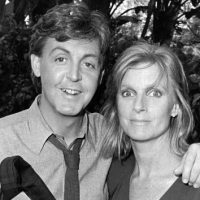
Paul & Linda McCartney, 1970s.
For other Beatles stories at this website, see the “Beatles History” topics page, and for a profile of John Lennon during his post-Beatles years, see the “Watching The Wheels” story. For additional stories on music history, artist and song profiles, and the music business, see the “Annals of Music” category page.
Thanks for visiting – and if you like what you find here, please make a donation to help support the research, writing, and continued publication of this website. Thank you – Jack Doyle
|
Please Support Thank You |
____________________________________
Date Posted: 15 March 2020
Last Update: 21 November 2021
Comments to: jdoyle@pophistorydig.com
Article Citation:
Jack Doyle, “McCartney: Amazed – The Paul & Linda
Story,” PopHistoryDig.com, March 15, 2020.
____________________________________
Sources, Links & Additional Information
“Paul McCartney,” in Holly George-Warren and Patricia Romanowski (eds), The Rolling Stone Encyclopedia of Rock & Roll, Rolling Stone Press, New York, 3rd Edition, 2001, pp. 624-627.
Sherryl Connelly, “Paul McCartney’s Girl-friends, Loves, and Lovers Documented in New Biography of Beatles Star,” New York Daily News, April 16, 2016.
“Linda McCartney,” Wikipedia.org.
Bryan Wawzenek, “The Day Paul McCartney Met Linda Eastman,” UltimateClassicRock .com, May 15, 2017.
“McCartney (album),” Wikipedia.org.
Kitty Empire, “Paul McCartney Leaves the Beatles (10 April 1970): Number 21 in Our Series of the 50 Key Events in the History of Rock Music,” TheGuardian.com, June 11, 2011.
Jann S. Wenner, “Q&A: Paul McCartney; Rolling Stone’s Founder Talks with the Rocker About His Solo Album and the Possibility of a New Beatles Record,” RollingStone.com, April 30, 1970.
“The Ex-Beatle Tells His Story: Interview of Paul McCartney,” Life, April 16th, 1971.
Tom Doyle, “’We Were Gypsies, a Bunch of Nutters on the Road. God, What Were We On?’: Paul McCartney’s Most Moving Interview Ever About Life with Linda,” DailyMail.co.uk, May 11, 2013.
“’Man on the Run’ Excerpt: Paul McCartney Threatened to Kick Linda Out of Wings and More,” Billboard.com, June 9, 2014.
Beatles Interviews Database, “Paul McCartney Interview: Beatles Break-Up 4/9/1970,” BeatlesInterviews.org.
“Break-Up of The Beatles,” Wikipedia.org.
Zach Baron, “Paul McCartney After the Beatles,” GQ.com, September 23, 2015.
Dalya Alberge, “She Loved Him: Linda McCartney’s 1960s Letters About Paul Revealed. In Three Handwritten Notes, the Late Photographer Writes About Her Budding Romance With The Beatle,” TheGuardian .com, November 24, 2019.
“Ram (album),” Wikipedia.org.
“Sir Paul McCartney Donates Photographs Taken by His Late Wife Linda to V&A Museum,… McCartney Has Made a ‘Major Gift’ of More than 60 Photographs Taken by His Late Wife Linda To The Victoria & Albert Museum,” Express.co.uk, May 3, 2018.
“Paul McCartney and Wings,” Wikipedia.org.
Paul McCartney Website, PaulMcCartney .com.
Alexis Petridis, “Paul McCartney on Linda’s Best Photos: ‘Seeing the Joy Between Me and John Really Helped Me.’ Linda Eastman Was the Award-Winning Photographer Who Captured a Generation of Rock Stars Before Marrying a Beatle. He Discusses How Her Work Changed His Life,” TheGuardian.com, June 26, 2019.
___________________________________
